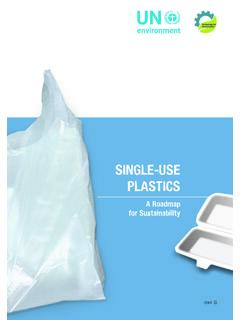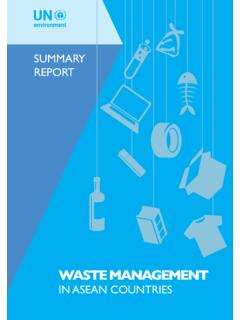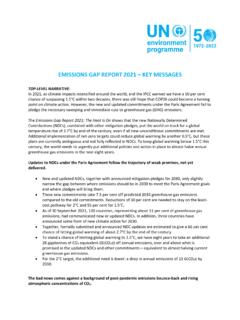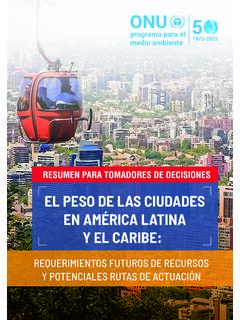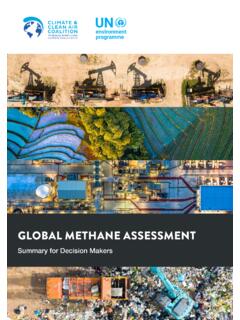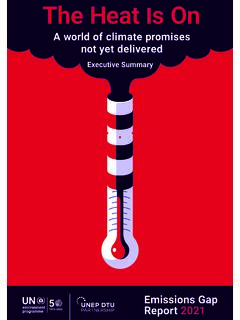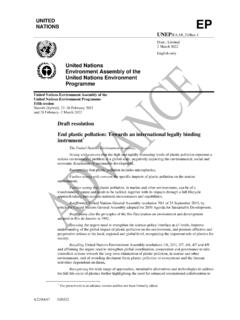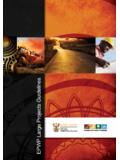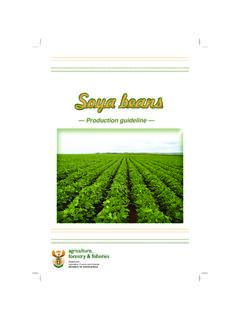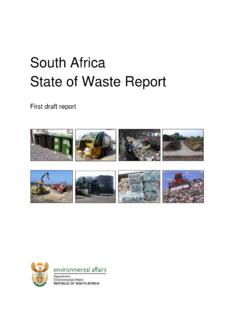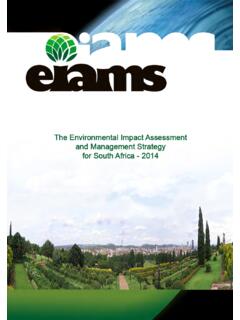Transcription of Making Peace with Nature - United Nations Environment ...
1 Making Peace with NatureA scientific blueprint to tackle the climate, biodiversity and pollution emergenciesUNEP promotesenvironmentally soundpractices globally andin its own activities. Ourdistribution policy aims to reduceUNEP s carbon footprint 2021 United Nations Environment Programme ISBN: 978-92-807-3837-7 Job No: DEW/2335/NAThis publication may be reproduced in whole or in part and in any form for educational or non-profit services without special permission from the copyright holder, provided acknowledgement of the source is made. United Nations Environment Programme would appreciate receiving a copy of any publication that uses this publication as a source. No use of this publication may be made for resale or any other commercial purpose whatsoever without prior permission in writing from the United Nations Environment Programme.
2 Applications for such permission, with a statement of the purpose and extent of the reproduction, should be addressed to the Director, Communication Division, United Nations Environment Programme, P. O. Box 30552, Nairobi 00100, Kenya. Disclaimers The designations employed and the presentation of the material in this publication do not imply the expression of any opinion whatsoever on the part of the Secretariat of the United Nations concerning the legal status of any country, territory or city or area or of its authorities, or concerning the delimitation of its fron-tiers or boundaries. Some illustrations or graphics appearing in this publication may have been adapted from content published by third parties.
3 This may have been done to illustrate and communicate the authors own interpretations of the key messages emerging from illustrations or graphics produced by third parties. In such cases, material in this publication do not imply the expression of any opinion whatsoever on the part of United Nations Environment Programme concerning the source materials used as a basis for such graphics or of a commercial company or product in this document does not imply endorsement by the United Nations Environment Programme or the authors. The use of information from this document for publicity or advertising is not permitted. Trademark names and symbols are used in an editorial fashion with no intention on infringement of trademark or copyright views expressed in this publication are those of the authors and do not necessarily reflect the views of the United Nations Environment Programme.
4 We regret any errors or omissions that may have been unwittingly publication was produced with the financial support of the European Union. Its contents are the sole responsibility of the United Nations Environment Programme and do not necessarily reflect the views of the European Union. Maps, photos and illustrations as specified Cover design : Joseph Schmidt-Klingenberg and Sebastian ObermeyerGraphic design : Joseph & SebastianLayout: Joseph & SebastianSuggested citationUnited Nations Environment Programme (2021). Making Peace with Nature : A scientific blueprint to tackle the climate, biodiversity and pollution Co-funded by:Acknowledgements(recent assessments; affiliation(s))Report Leads: Ivar A.
5 Baste (GEO, IPBES; Norwegian Environment Agency, Norway) and Robert T. Watson (IPCC, IPBES; UEA, UK)Section Leads: Kate A. Brauman (IPBES; University of Minnesota, USA), Kai M. A. Chan (IPBES; University of British Columbia, Canada), Nebojsa Nakicenovic (The World in 2050, IPCC; International Institute for Applied Systems Analysis, Austria), Paul L. Lucas (GEO, GBO; PBL Netherlands Environmental Assessment Agency, the Netherlands), Stephen Polasky (IPBES; University of Minnesota, USA) and Robert J. Scholes (IPBES, IPCC; University of the Witwatersrand, South Africa)Authors: Ricardo Barra (GEO, GCO; University of Concepci n, Chile), Eduardo S. Brondizio (IPBES, GEO-6; Nepam-Unicamp, Brazil, Indiana University, USA), Shob-hakar Dhakal (IPCC, GEO-6; Asian Institute of Technology, Nepal), Rebecca M.
6 Garland (IPCC; Council for Scientific and Industrial Research, South Africa), Yacob Mulugetta (IPCC; University College London, UK), Paul A. Newman (Montreal Protocol s Scientific Assessment Panel; NASA Goddard Space Flight Center, USA), Belinda Reyers (IPBES; Stockholm Resilience Centre, Sweden), Cristi n Samper (Wildlife Conservation Society, USA), Sonia I. Seneviratne (IPCC; ETH Z rich, Switzerland), Detlef van Vuuren (IPBES, IPCC, GEO-6; PBL Netherlands Environmental Assessment Agency, the Netherlands), Chris Walzer (Wildlife Conservation Society, USA), Rachel Warren (IPCC; University of East Anglia, UK), Bianca Wernecke (South African Medical Research Council, South Africa) and Caradee Y.
7 Wright (IPCC, GEO-6; South African Medical Research Council, South Africa)Scientific Advisory Group: Hesiquio Benitez-Diaz (CONABIO, Mexico), Julia Carabias (National Autonomous University of Mexico, Mexico), John M. Christen-sen (IPCC; UNEP-DTU, Denmark), H. David Cooper (GBO; CBD, UK), Paul Ekins (IPCC, GEO-6; University College London, UK), David W. Fahey (IPCC; NOAA, USA), Joyeeta Gupta (IPCC, GEO-6; University of Amsterdam, the Netherlands), Madhav Karki (IPBES; Centre for Green Economy Development, Nepal), Nicholas King (IPBES, IPCC, GEO-6; North West University, South Africa), Thomas Lovejoy (Amazon Biodiversity Center, USA), Jock Martin (European Environment Agency, Denmark), Val rie Masson-Delmotte (IPCC; French Alternative Energies and Atomic Energy Commission, France), Peter Messerli (GSDR; University of Bern, Switzerland) Shantanu Mukherjee (UNDESA, India), Endah Murniningtyas (GSDR.)
8 Indonesia Agriculture Economist Association, Indonesia), Bruno Oberle (Swiss Agency for the Environment , Forests and Landscape, Switzerland), Janez Poto nik (GRO; SYSTEMIQ, Slovenia), Debra Roberts (IPCC; eThekwini Municipality, Durban, South Africa), Johan Rockstr m (GEO-6; Potsdam Institute for Climate Impact Research, Germany), Cyrie Sendashonga (IUCN, Canada), Sonali Sena-ratna Sellamuttu (IPBES; International Water Management Institute, Sri Lanka), Jim Skea (IPCC; Imperial College London, UK) and Youba Sokona (IPCC; African Climate Policy Centre, Mali)Research Fellows: Maria Jesus Iraola (GEO-6; Asesoramiento Ambiental Estrat gico, Uruguay), Akshay Jain (GEO-6; Mesotope Pte Ltd, India), Tooba Masood (GEO-6; Asian Institute of Technology, Pakistan), Jaee Nikam (GEO-6; Stockholm Environment Institute, India), Amit Patel (GEO-6; Cadmus Group LLC, USA), Priti Patel (GEO-6; NU Borders LLC, USA), Semie Sama (GEO-6; McGill University, Canada), Samanta Villegas Espinosa (GEO-6; Fundaci n de Conservaci n Jocotoco, Ecuador), Leila Zamani (GEO-6.
9 Department of Environment of Islamic Republic of Iran, Iran) and Emily Zhang (The George Washington University, USA)Reviewers: Sandy Sheard (The Dasgupta Review), Valentin Foltescu and Pushpam Kumar (UNEP Economy Division), Linxiu Zhang, Tim Christopherson, Michele Poletto, Riccardo Zennaro and Doreen Robinson (UNEP Ecosystems Division), Arnold Kreilhuber (UNEP Law Division), Susan Mutebi-Richards and Marieta Saka-lian (UNEP Policy and Programme Division), Sandra Averous-Monnery (UNEP Chemicals and Health Branch), Daniel Cooney (UNEP Communications Division), Jian Liu and Ludgarde Coppens (UNEP Science Division), Jinhua Zhang (UNEP Asia-Pacific Office), Tomas Marques (UNEP Europe Office), Simi Thambi and Divya Datt (UNEP India Office)
10 , Jason Jabbour, Jane Eisenhardt and Logan Ende (UNEP North America Office), Neville Ash and Hilary Allison (UNEP-WCMC), Katarina Magulova (Basel, Rotterdam and Stockholm Conventions), Alexander Shestakov, Jillian Campbell, Kieran Noonan-Mooney, Christopher Pereira, Julie Botzas-Coluni, Caridad Canales and Joseph Appiott (Convention on Biological Diversity), Tom De Meulenaer (Convention on International Trade in Endangered Species of Wild Fauna and Flora), Christina Bodouroglou (International Resource Panel), Eisaku Toda (Minamata Convention on Mercury), Tina Birmpili, Meg Seki and Sophia Mylona (Vienna Convention for the Protection of the Ozone Layer)Report Production TeamUNEP Secretariat Core team: Rachel Kosse, Brigitte Ohanga, Adele Roccato and Edoardo ZandriExtended team: Pierre Boileau, Caroline Kaimuru, Maarten Kappelle, Jian Liu, Caroline Mureithi, Josephine Mule, Franklin Odhiambo, Pinya Sarasas and Sharif ShawkyCommunications Team: David Cole, Daniel Cooney, Florian Fu stetter, Maria Vittoria Galassi, Stephen Graham, Nancy Groves, Duncan Moore, Pooja Munshi, Stephanie Pascale Foote, Keishamaza Rukikaire, Reagan Sirengo and Neha SudDesign and layout: Sebastian Obermeyer and Joseph Schmidt-Klingenberg Science Communications Editor: Stephen GrahamMaps.

